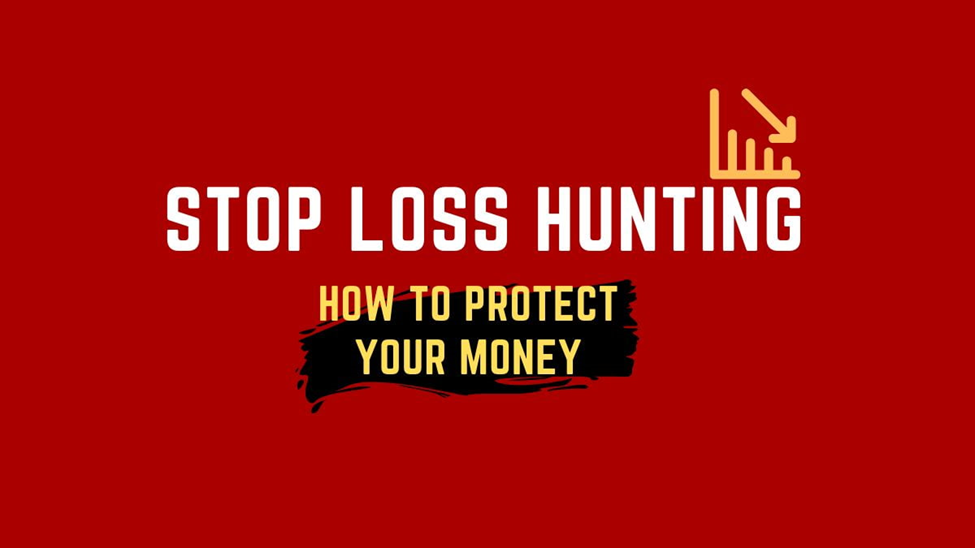
Stop-loss hunting is a practice in financial markets where large traders, often institutional traders or market makers, use the mechanics of stop-loss orders to push their position to bigger profits. This is accomplished by moving the price of an asset up or down to a point where a large number of traders are likely to have placed stop-loss orders. This causes the price of an asset to activate automated stop-loss orders placed by other market participants. Activating so many stop losses simultaneously often causes a lot of volatility, which presents an opportunity for investors looking to trade in this scenario.
Larger traders are frequently responsible for this manipulation, inflicting significant losses on retail traders while benefitting themselves. As a result, many people believe that stop-hunting hurts market integrity.
This blog post aims to discuss the concept of stop-loss hunting, how it works, and the techniques you may use to avoid becoming a victim of this practice.
Understanding Stop-Loss Hunting
Have you ever entered a trade believing that the price of an asset was rising and employed a stop-loss to minimize your risk, only to have the stop-loss pull you out of what could have been a lucrative trade?
It could have been due to an abrupt and only temporary reduction in price before rising, but the stop-loss kept you out. Your sell order was triggered, and you were out of the trade. But you then observed the market reversed nearly immediately after your stop-loss was struck. The reason was buyers got in and skyrocketed the price.
Despite having the right concept, you missed out on the trade. The turnaround was so perfect that it seemed like someone was hunting for your exact sell level.
Stop loss hunting is an unorthodox trading strategy employed by large players called Smart Money, including hedge funds and investment banks that have the requisite resources. They seek out clusters of stop orders in order to take large, high-volume positions for their own larger trades.
Stop Hunting Example:
Let’s say company ABC is trading stocks at $50.36, and investors expect that it may go lower in the short run. Many market participants place their stop-loss orders below $50 to save their trading capital and gain from an upward increase while reducing negative risk. If the price drops below $50, traders anticipate a deluge of sell orders as many stop losses are activated. This will cause prices to fall and permit some whales to benefit from the drop or even bullish trades as they expect the price to rebound to the prior range.
How do Large Traders Know Where Small Traders Stop Losses Are?
Determining where most retail traders’ stop-loss orders are set up is not difficult. A large number of them employ similar technical analysis methodologies and indicators. This implies that many traders will frequently place their stop-loss orders at the same levels. The outcome is the formation of at least two regions where there is a large concentration of Stop-Loss orders.
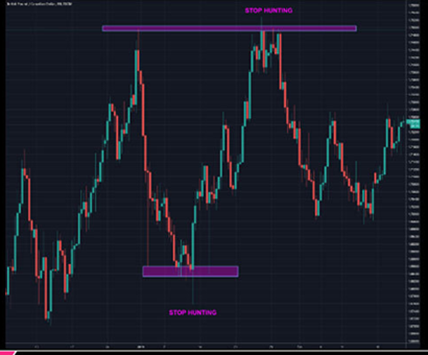
When viewed on a chart, it is quite simple for anyone to figure out where these regions are, and considerably easier for Smart Money traders.
The most common technical levels that retail traders utilize to mask their protective stop losses include:
- Just above the resistance or just below the support levels of a trend.
- Prior swing high or swing low
- Above/below chart patterns
- Above/below technical indicators
- Big round numbers
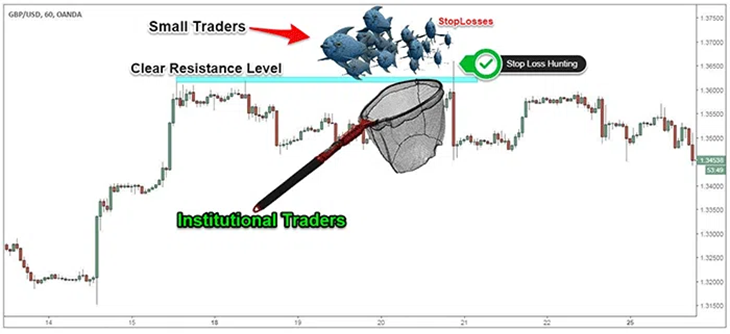
Stop losses will be packed around these evident levels, and market manipulators will bid the market at those specific technical levels to obtain the liquidity required to fill large orders at the expense of individual traders.
How to Know if You Are Being Stop Hunted?
In most cases, smaller traders are unaware that they are being searched by stop hunters. The problem becomes obvious only after it has occurred. However, some signs can help you in detecting stop hunting.
- Sudden Surge in Trading Volume: A sudden increase in volume may suggest that large market players are pushing the market and contributing volume and price action to it. They may intend to cause quick price changes, triggering stop-losses of other traders.
- Repeated Stop Runs: This occurs when the market consolidates within a range. The price continues to run towards the range’s highs and lows, looking for liquidity above and below them before reversing in the opposite direction.
- High Slippage or Spread: Unusually high slippage (difference between actual and predicted execution prices) and spread (difference between the ask and bid prices) are two common indicators of the occurrence of stop hunting and market manipulation.
- High Volatility: Extreme price movements are usual during these situations. These violent price swings mostly target stop-loss orders or are the result of liquidation cascades.
Why Big Players Hunt Stop Losses?
There are several different reasons why a market maker engages in stop hunting, particularly in the forex market. Their requirements differ from those of a retail trader. The trades of a small trader are usually not substantial enough to make it difficult to enter them. There are usually enough sellers and liquidity for them to enter a deal. However, market makers face difficulties due to a lack of liquidity for such huge trades. They need enough sellers to fill the enormous position they seek.
These institutional traders, financial institutions, crypto whales, and mining pools are taking advantage of the wall of stopped-out sellers to supply liquidity and preferential prices. The hunters are generating a large number of sellers from activated stop-loss orders of dozens of regular traders as well as from short-sellers, who may establish a short position if a key threshold is breached.
How Do Big Players Manipulate Prices to Stop Hunt?
Market manipulators frequently have large sums of capital to handle, and while this may seem contradictory, there are significant disadvantages to it as compared to regular traders.
Big traders may have difficulty placing large orders and seeing them fulfilled at the appropriate price. They frequently find themselves having to break large trades into smaller ones, put orders over longer periods, and disperse them between numerous brokers. However, these activities involve time, and there is no certainty that any slippage will be limited.
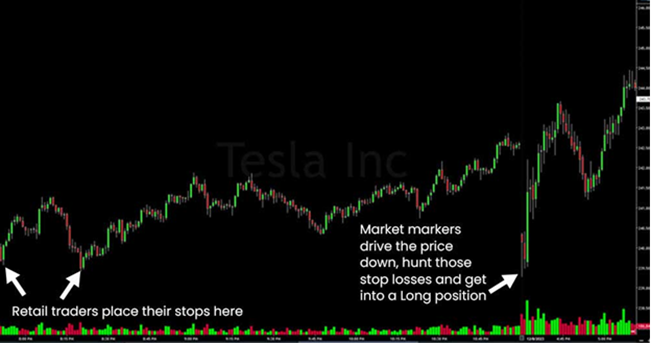
Since their capital is so huge, big players can “sacrifice” a little portion of it to quickly buy or sell an enormous number of shares within one or two deals, pushing a stock price toward individual traders’ stop-loss and driving it far enough to activate as many of them as possible.
When stop-loss orders are activated, they become market orders, and all holdings are liquidated at the subsequent available price. This indicates that when a stop-loss order is triggered below the support line, there will be a sudden rise in selling pressure and the price will continue to fall, and when a stop-loss order is triggered above the resistance line, the reverse is true. At this moment, big players can take advantage of the plenty of liquidity and a reduced rate to establish a long position or a higher price for placing a short position.
The key motives for stop-loss hunting are to create liquidity in the market so that larger deals may be executed and to acquire a more advantageous trading price. By initiating stop-loss orders, these market participants seek to capitalize on the chain reaction caused by multiple stop-loss orders being triggered at a single time, while also getting a higher price that allows them to accumulate or dump stock more effectively.
Now let us go to something very important.
How to Avoid Stop Loss Hunting by Setting a Right Stop Loss?
Now that we know what stop loss hunting is and why some big players choose to adopt it as a trading strategy, it is natural for traders to wonder if there are any steps, they can take to avoid falling into the trap of market makers.
The reality is that it is impossible to avoid stop hunting completely, as that would be like asking if we can avoid losses entirely.
The market moves where it desires, and all that can be done is to participate in the movement and cut your losses if you are incorrect.
Still, how can we avoid stop loss hunting?
You want to set a good stop loss so that you are not stopped out “too soon”.
There are several strategies to avoid stop hunting. Let us explain three techniques:
- Don’t place stop loss above resistance or below support
- Don’t place a stop-loss order at an arbitrary level
- Set stop loss order at a level where it invalidates the trading setup
Now let us explain them in detail.
Don’t Place Stop Loss Above Resistance or Below Support
It is now evident to you that setting your stop loss order just below support (or above resistance) is an unwise decision. The reason is it is the point where most traders set their stop loss.
This encourages the big traders to push the price to that region since it provides them with better entry and exit points for their trades.
You may now be thinking what is the appropriate way of setting your stop loss. Your stop loss should be set at a distance from support/resistance.
For instance, you can employ the Average True Range (ATR) indicator to determine how much “buffer” you want to apply. It could be one, two, or three ATR away from the support and resistance region.
ATR allows you to set your stop-losses at a level that takes into account the security’s volatility. This may assist you avoid placing your stops too near the current price, which might render them vulnerable to raiding.
For example, if an asset’s current price is $50 and its ATR is $2, you might choose to place your stop-loss at $48. This would provide enough room for the price to change without activating your order.
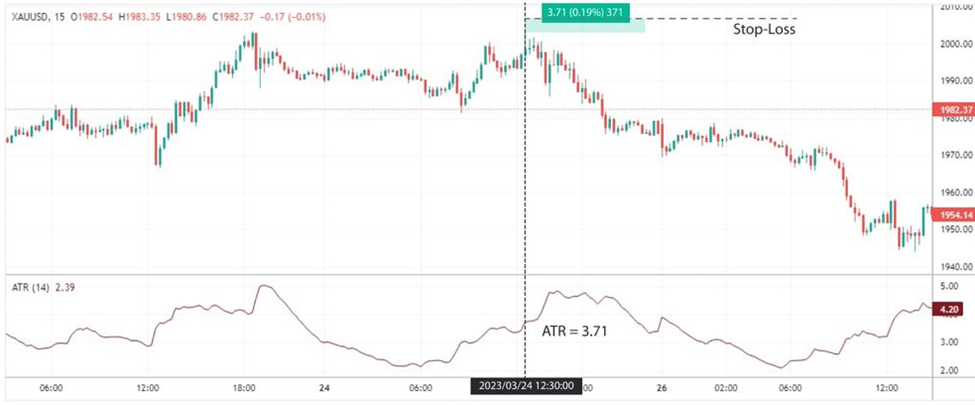
Don’t place a Stop-Loss Order at an Arbitrary Level
It’s surprising how most traders are fascinated with the ideal entry, attempting to catch the very top and bottom of the market, but are unaware of the importance of placing the stop loss at the right point instead of an arbitrary level.
They do it probably because they think of it as an effective risk management. So, they place it in the simplest way possible, such as 50 pips, 100 pips, or even 200 pips.
But the real catch is that the market ignores where you place your stop loss. It goes from one area of liquidity to the next, and if you set your stop loss at random, it will be devoured alive.
You may be wondering what is the proper way of setting a stop loss. The usual rule is this:
Your stop loss should be set at a level that invalidates your trading strategy. We’ll go into greater detail in the following part.
Continue reading.
Set Stop Loss at a Level where it Invalidates the Trading Setup
Entering a trade usually follows a technical pattern, such as breakouts or pullbacks. As a result, it makes sense for your stop loss to be set at a level that invalidates your technical pattern.
This implies that if you are trading a breakout, set your stop loss at a level where if the price hits it, the breakout will fail. If you are trading a pullback, set your stop loss at a level where if the price hits it, the pullback fails. If you’re trading chart patterns, set your stop loss at a level where if the price hits it, the chart pattern will fail.
Once you’ve specified an appropriate stop loss, the next step is to use proper position sizing to avoid losing a large piece of your money – even if you’re incorrect about the trade.
Conclusion
Stop hunting is a method used by big players to strive for larger short-term gains while pushing smaller participants out of their holdings. The goal is to trigger a significant number of stop losses by adjusting the price and volume. It opens up a larger range of long and short positions for so-called whales.
Besides, stop-loss hunting occurs everywhere. Whether it’s currencies, commodities, stock market, or indices, large dealers target small traders for making money. To be a successful trader, you must accept that it is an actual practice that requires caution.
Remember that while the management tips help mitigate the effects of stop hunting, they cannot entirely avoid stop hunting. Moreover, it is not always intentional. Price volatility and liquidity challenges can occasionally cause stop losses to be executed repeatedly.


